Lake Tahoe, nestled in the Sierra Nevada Mountains, is a pristine freshwater lake that serves as a natural habitat for a wide variety of wildlife, including several bird species.
The spectacular shoreline and crystal blue waters of the lake offer an idyllic location for birdwatchers and nature enthusiasts.
The diverse range of birdlife in Lake Tahoe is due to the unique combination of high elevation, diverse habitats, seasonal weather, and migratory patterns.
From the bald eagle to the common loon, these winged creatures can be seen throughout the year, making Lake Tahoe a veritable bird-watching paradise.
In this article, we will delve into some of the fascinating birds that call Lake Tahoe their home.
1. Dark-Eyed Junco

The Dark-eyed Junco is a species of small, grayish sparrows that are found across much of temperate North America and in the Arctic during summer.
It was formally described by Carl Linnaeus in 1766, who named it after its distinctive dark eyes.
This bird has a very variable appearance due to the many different subspecies it contains, making its systematics difficult to unravel.
The plumage varies from white or light gray on their underparts with slate grey backs and wings; black heads with white outer tail feathers; brown head stripes; yellow bills; pink legs and feet; as well as various shades between all these colours.
They also have considerable sexual dimorphism where males tend to be more colourful than females but share similar characteristics such as short tails and rounded bodies – both sexes being around 16 cm long when fully grown.
Scientific classification:
| Kingdom | Animalia |
| Phylum | Chordata |
| Class | Aves |
| Order | Passeriformes |
| Family | Passerellidae |
| Genus | Junco |
| Species | J. hyemalis |
Also Featured In: Most Common United States Birds, New Hampshire Birds You Should Know
2. California Gull

The California Gull is a medium-sized bird, smaller than the herring gull but larger than the ring-billed gull. It has a yellow bill with black ring and yellow legs.
Its head is rounder compared to other gulls and its body mainly white in color with grey back and wings.
They are mostly found around lakes, rivers or coasts of western North America where there is plenty of food available for them such as fish, insects and crustaceans which they consume on their daily diet.
During breeding season these birds form large colonies near water bodies or wetlands where they also make their nests using grasses sticks or feathers.
As omnivores they play an important role in maintaining balance within local ecosystems by eating both plants material like seeds & fruits as well as small mammals like rodents.
Scientific classification:
| Kingdom | Animalia |
| Phylum | Chordata |
| Class | Aves |
| Order | Charadriiformes |
| Family | Laridae |
| Genus | Larus |
| Species | L. californicus |
Also Featured In: Birds that Live in San Francisco Bay Area, Yellowstone National Park Birds You Need To Know
3. Mountain Chickadee
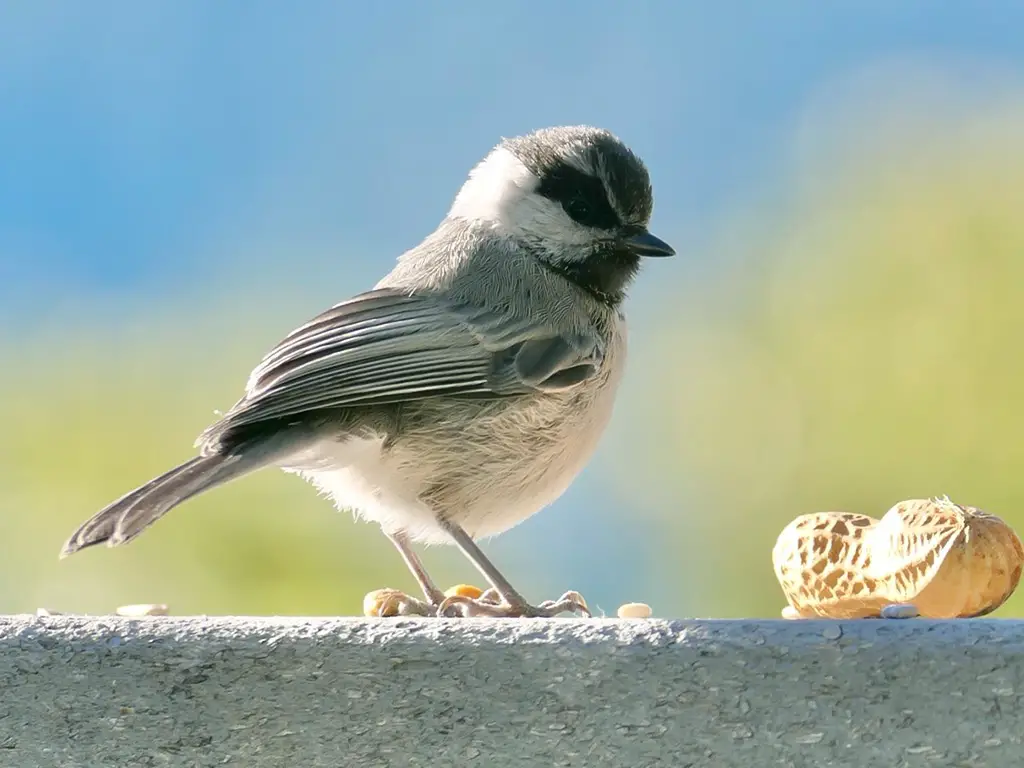
The Mountain Chickadee is a small songbird in the tit family Paridae. It’s distinct features include its black cap and bib, white cheeks, gray back and buffy underparts.
This bird was named after an American naturalist called William Gambel.
Recent studies have suggested that this species should be separated from other tits due to differences in their mitochondrial DNA cytochrome B sequence data as well as physical characteristics such as morphology.
They inhabit coniferous forests of North America between Alaska’s Aleutian Islands all the way down to northern Mexico.
The diet of these birds consist mainly on insects but they are also known to eat seeds and berries at times.
These active little birds often join mixed-species foraging flocks during wintertime with other chickadees, nuthatches or kinglets which helps them survive colder climates by pooling resources together when food sources become sparse.
Scientific classification:
| Kingdom | Animalia |
| Phylum | Chordata |
| Class | Aves |
| Order | Passeriformes |
| Family | Paridae |
| Genus | Poecile |
| Species | P. gambeli |
Also Featured In: Chickadees Birds, Most Common Winter Birds
4. Townsend’s Solitaire
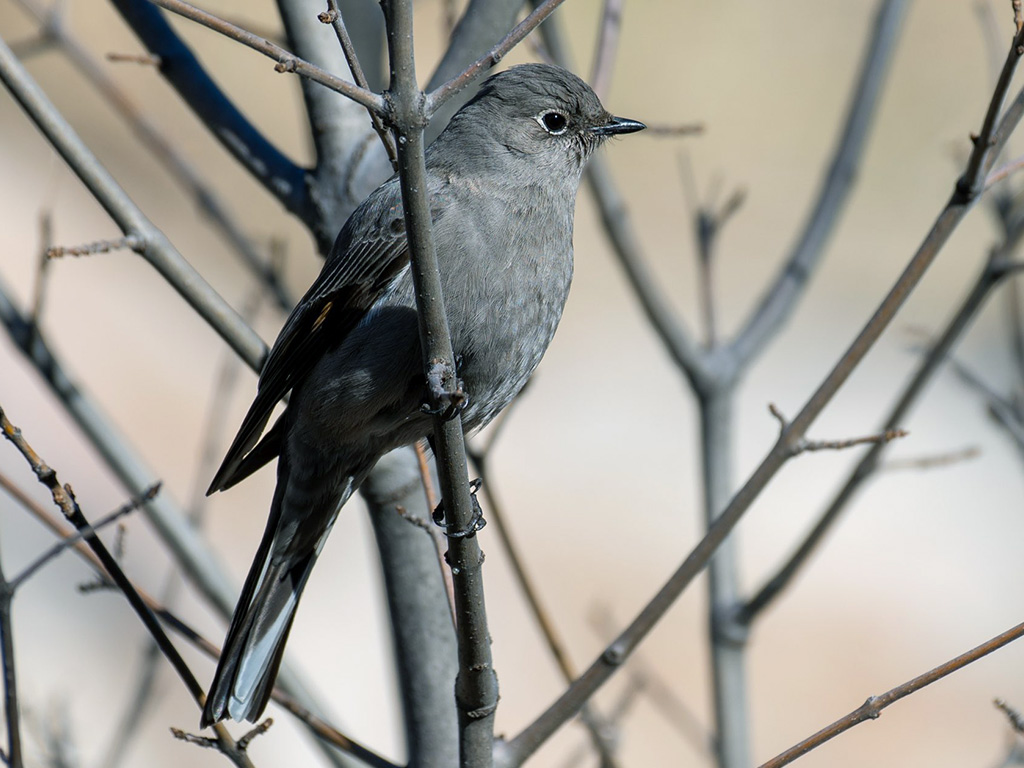
Townsend’s solitaire is a medium-sized thrush native to North America, ranging from Alaska and Canada all the way down to Zacatecas in Mexico.
It prefers montane woodlands but will travel for food during winter months – sometimes all the way down to Great Plains or desert oases.
This bird has distinct features such as grey upperparts with white spots on wings, buff underparts and light streaks on its head.
The Townsend’s Solitaire also makes an interesting sound – it produces melodic whistles which can be heard across long distances within forested areas.
Despite this birds beauty and song however, populations have been declining due largely to habitat destruction caused by logging activities.
Scientific classification:
| Kingdom | Animalia |
| Phylum | Chordata |
| Class | Aves |
| Order | Passeriformes |
| Family | Turdidae |
| Genus | Myadestes |
| Species | M. townsendi |
Also Featured In: Thrush Species, Birds in Calgary You’ll Love to See
5. White-Headed Woodpecker
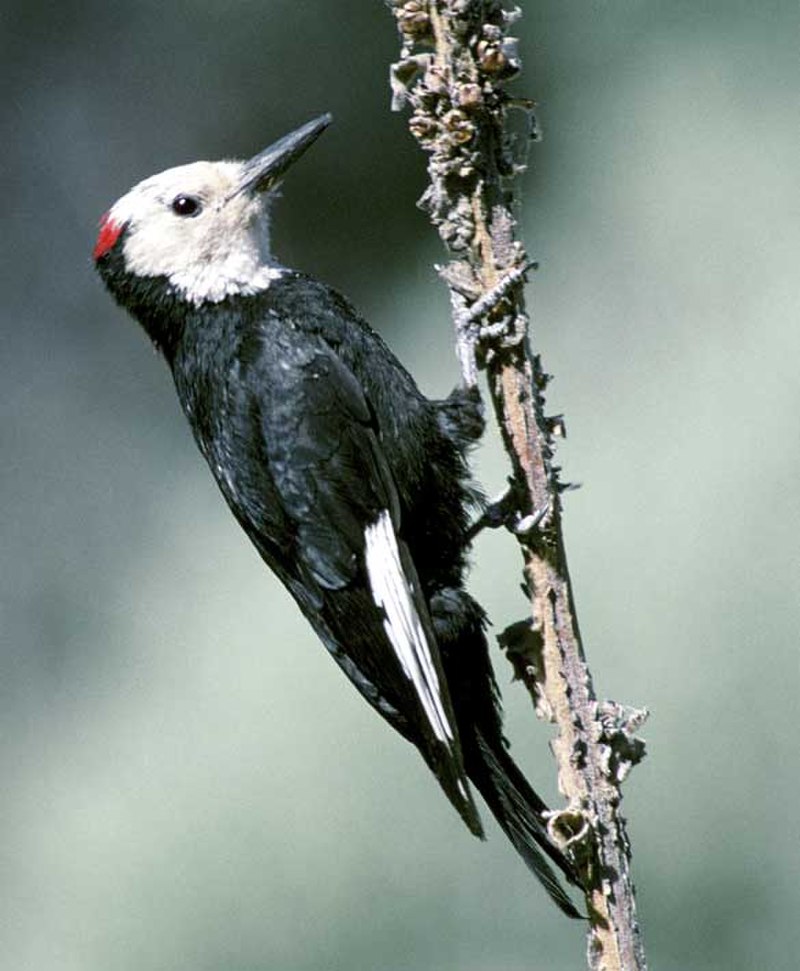
The white-headed woodpecker is a beautiful, non-migratory bird native to the pine forests of western North America.
It has a black body that measures around 20 cm in length and a distinctively white head with crescent shaped primary feathers.
The male also features an attractive red spot at the back of its head as well.
This range stretches from British Columbia down through California, Arizona and New Mexico; they typically inhabit elevation ranging between 900–3000 m above sea level but can be found up to 4200 m on occasion.
They are omnivorous birds that feed mainly on insects such as ants and beetles, although they will occasionally supplement their diet with fruits or nuts when available.
All in all, this truly remarkable species offers much for us to admire about it.
Scientific classification:
| Kingdom | Animalia |
| Phylum | Chordata |
| Class | Aves |
| Order | Piciformes |
| Family | Picidae |
| Genus | Leuconotopicus |
| Species | L. albolarvatus |
Also Featured In: Woodpeckers Species, Most Common Lake Birds
6. Yellow-Headed Blackbird
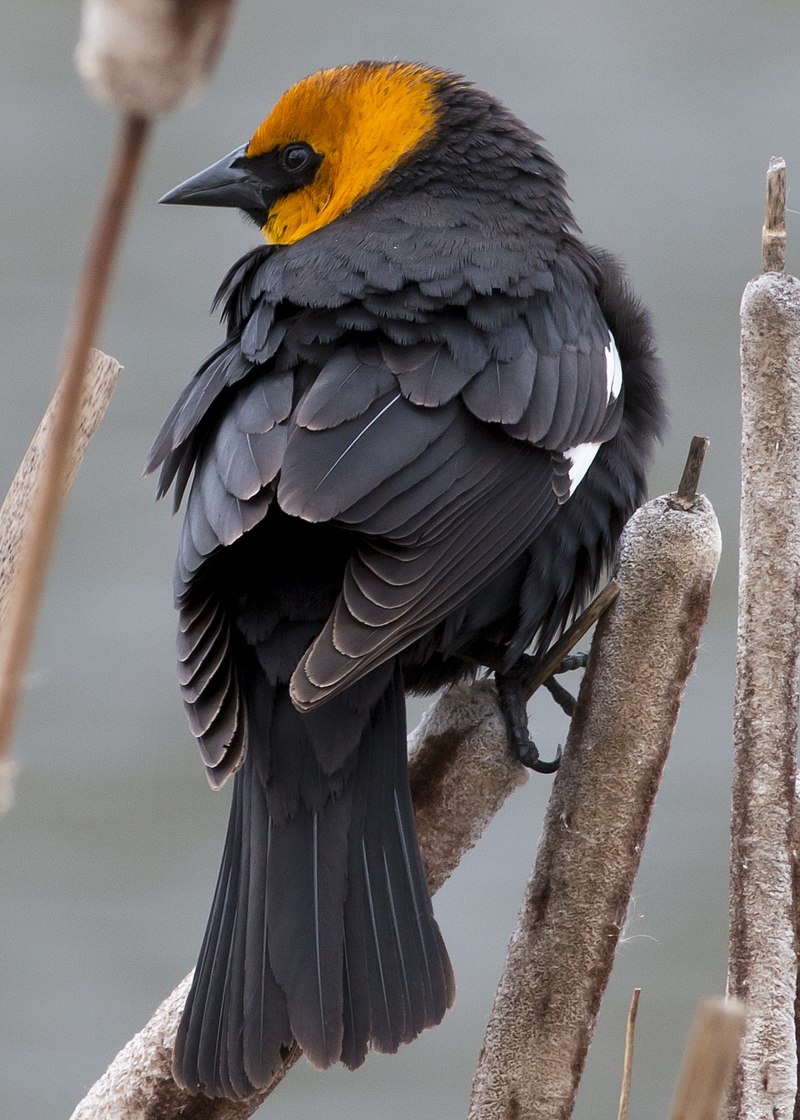
The yellow-headed blackbird is a medium-sized bird with striking features – its head and neck are bright yellow, while the rest of its body is black.
It has large eyes, a pointed bill and long wings that help it to soar through the air.
The species gets its name from Greek words meaning ‘yellow’ (xanthous) and ‘head’ (cephalus).
This species can be found in wetlands across North America during summer months where they feed on insects and other invertebrates such as snails, earthworms, spiders and crustaceans.
During winter months they migrate southward for food or when temperatures drop too low for their comfort.
They also form flocks which makes them more visible than solitary birds like hawks or owls. Yellow-headed Blackbirds make beautiful sounds that echo around wetland areas; these melodic calls bring joy to many nature lovers.
Scientific classification:
| Kingdom | Animalia |
| Phylum | Chordata |
| Class | Aves |
| Order | Passeriformes |
| Family | Icteridae |
| Genus | Xanthocephalus Bonaparte, 1850 |
| Species | X. xanthocephalus |
Also Featured In: Utah Birds, Birds Live in Arkansas
7. Western Tanager
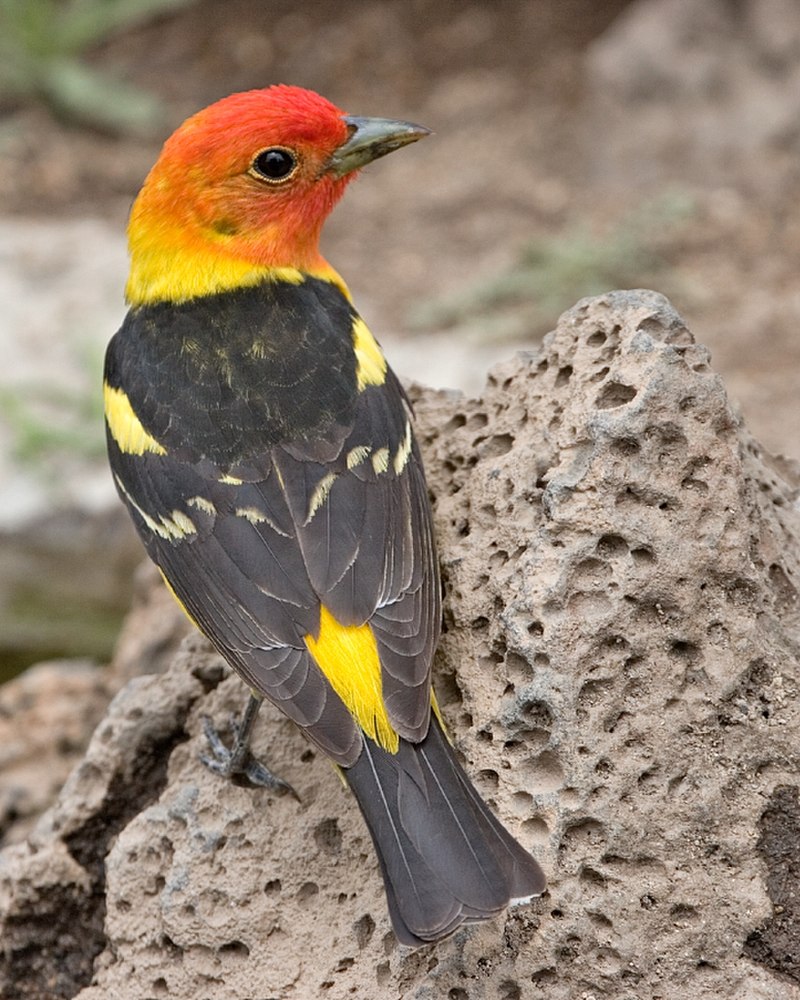
The Western Tanager (Piranga ludoviciana) is a medium-sized songbird belonging to the cardinal family, Cardinalidae. It was illustrated and formally described by American ornithologist Alexander Wilson in 1811.
The species has distinctive plumage including yellow feathers on its wings and tail, red shoulders, black head with white forehead patch and grayish underparts.
Its vocalizations are also very similar to other members of the cardinal family – they have a high pitched ‘tsee’ note followed by several sweeter notes that come together as parts of complex songs.
They primarily feed on fruit but will also take insects when available for extra protein during breeding season.
These beautiful birds can be found throughout western North America from Alaska down through Mexico making them an iconic part of many landscapes.
Scientific classification:
| Kingdom | Animalia |
| Phylum | Chordata |
| Class | Aves |
| Order | Passeriformes |
| Family | Cardinalidae |
| Genus | Piranga |
| Species | P. ludoviciana |
Also Featured In: Birds that Found in the Yellowstone , Birds that Live in Yosemite National Park
8. Steller’s Jay
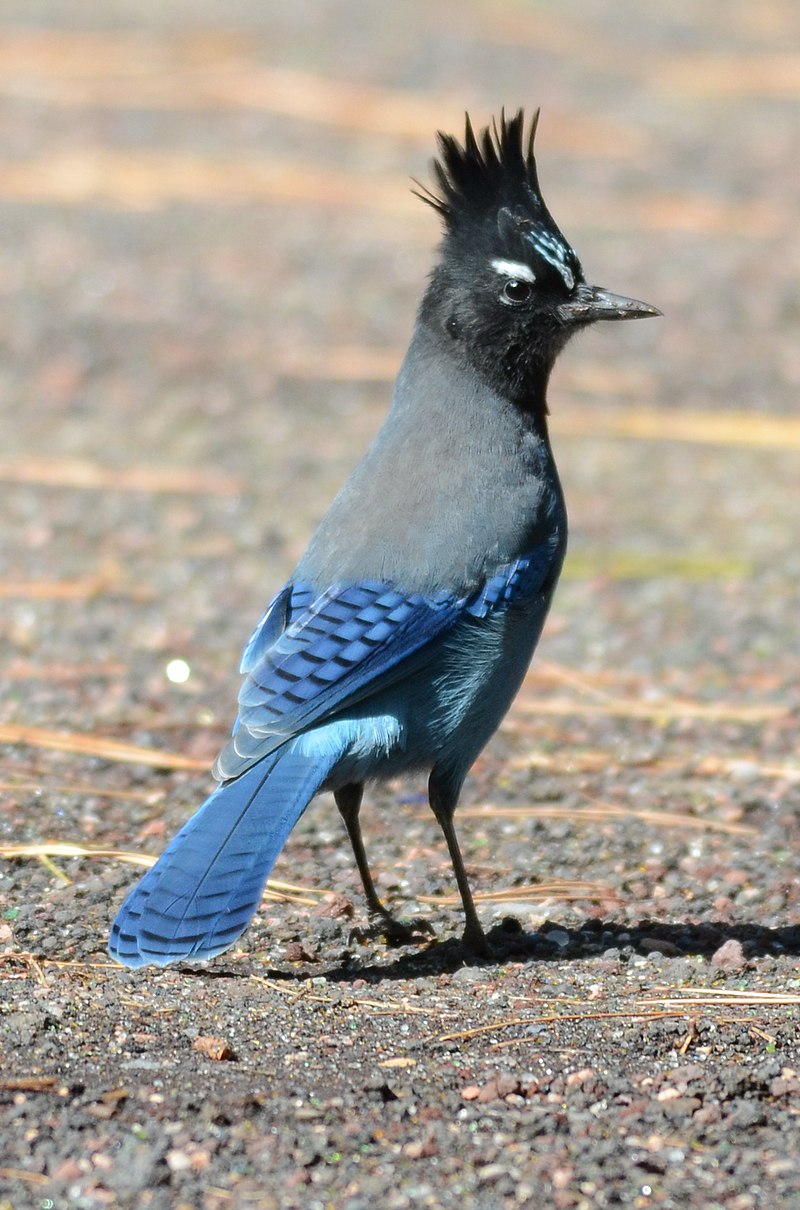
Steller’s jay is a beautiful and colorful bird native to western North America and the mountains of Central America.
It has a distinctive long crest that sets it apart from other birds, with its blue feathers streaked with black, white, gray, and brown markings.
This species is closely related to the blue jays found in eastern North America but can be distinguished by their longer crests.
They are known for being highly vocal birds who like to make loud calls throughout forests they inhabit as well as stealing food from unsuspecting mammals or raiding bird feeders when given the chance.
Steller’s Jays have adapted well to human presence in areas they populate making them great backyard visitors if you’re lucky enough.
Scientific classification:
| Kingdom | Animalia |
| Phylum | Chordata |
| Class | Aves |
| Order | Passeriformes |
| Family | Corvidae |
| Genus | Cyanocitta |
| Species | C. stelleri |
Also Featured In: Alaska Birds, Birds That Live in Colorado
9. Clark’s Nutcracker
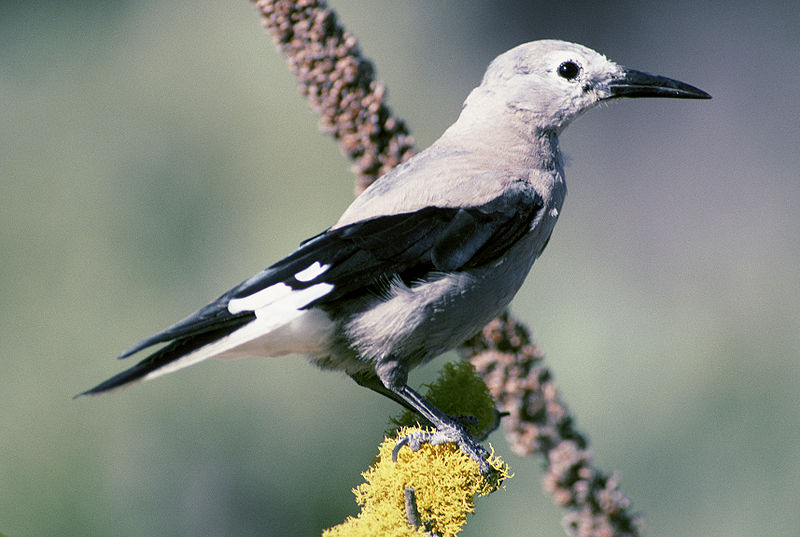
Clark’s nutcracker is a passerine bird in the Corvidae family, native to western North America. It has two alternate names: Clark’s crow and woodpecker crow.
Its primary food source are pine nuts which it stores for later retrieval by memory during winter months when other food sources may be scarce.
This omnivore also enjoys eating seeds, fruits and insects as part of its diet.
The species was first described by Lewis and Clark Expedition members in 1806 who noted that Native Americans used their feathers for ceremonial purposes due to their beauty.
They have distinctive black-and-white patterned wings with grey bodies sporting white underbellies.
They prefer open coniferous forests at higher altitudes where they can build nests on trees or cliffsides using twigs lined with soft materials such as grasses or mosses while taking advantage of natural cavities like stumps or hollows if available.
Scientific classification:
| Kingdom | Animalia |
| Phylum | Chordata |
| Class | Aves |
| Order | Passeriformes |
| Family | Corvidae |
| Genus | Nucifraga |
| Species | N. columbiana |
Also Featured In: birds of Wyoming, Birds that Live in Vancouver
10. Northern Flicker
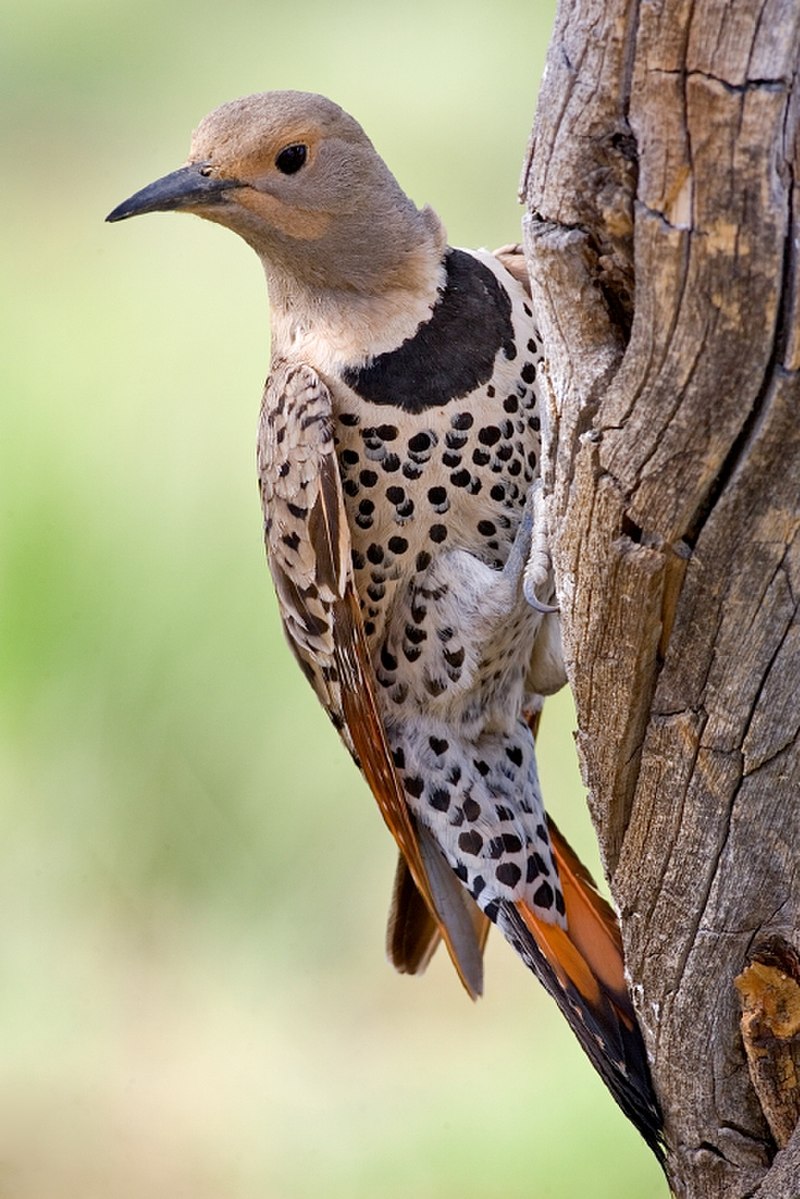
The Northern flicker is a woodpecker species found in North America, Central America, Cuba, and the Cayman Islands. This medium-sized bird is known for its unique migration behavior.
Over 100 common names are used to refer to the Northern flicker, one of them being “yellowhammer”. It is a beautiful bird with distinctive markings and a colorful plumage.
The Northern flicker is an important species in its ecosystem and plays a key role in maintaining a healthy balance in the environment.
Despite being a woodpecker, the Northern flicker has a diverse diet that includes insects, fruits, and seeds.
It is fascinating to observe this bird as it pecks at trees in search of food, communicates with its unique vocalizations and performs its incredible aerial displays.
The Northern flicker is truly a remarkable bird species that is worthy of our admiration and protection.
Scientific classification:
| Kingdom | Animalia |
| Phylum | Chordata |
| Class | Aves |
| Order | Piciformes |
| Family | Picidae |
| Genus | Colaptes |
| Species | C. auratus |
Also Featured In: Birds Commonly Found in New York, Common Birds in the Cities